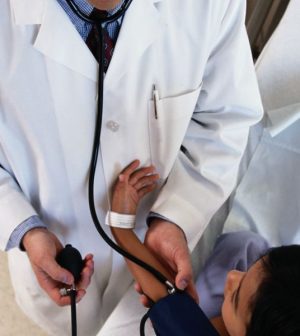- Navigating Your Midlife Crisis: Embracing New Possibilities
- City Raccoons Showing Signs of Domestication
- Mapping the Exposome: Science Broadens Focus to Environmental Disease Triggers
- One Week Less on Social Media Linked to Better Mental Health
- Your Brain Changes in Stages as You Age, Study Finds
- Some Suicide Victims Show No Typical Warning Signs, Study Finds
- ByHeart Formula Faces Lawsuits After Babies Sickened With Botulism
- Switch to Vegan Diet Could Cut Your Greenhouse Gas Emissions in Half
- Regular Bedtime Does Wonders for Blood Pressure
- Dining Alone Could Mean Worse Nutrition for Seniors
Don’t Rely on Just One Blood Pressure Test for Kids: Study

It’s important to take a second blood pressure reading if your child’s first reading points to high blood pressure, researchers say.
They found that nearly 25 percent of children and teens who had their blood pressure checked by their primary care doctor had readings in the high range, but less than half of those readings were confirmed when their blood pressure was checked again.
In fact, just slightly more than 2 percent of the children had sustained high blood pressure over time, the researchers found.
The study included data from more than 755,000 Kaiser Permanente patients, aged 3 to 17, in Southern California.
“Pediatricians don’t diagnose hypertension in children very often, but if it is there, we want to find it,” said study author Dr. Robert James Riewerts, regional chief of pediatrics for the Southern California Permanente Medical Group.
“This study is important because it demonstrates the best path to accurately diagnose hypertension in a child or teen,” he said in a Kaiser Permanente news release. “Taking a second blood pressure reading is something all clinicians must consider when the initial reading is elevated.”
It’s common for the blood pressure of children and teens to vary quite a bit, the researchers noted. What’s considered high blood pressure also varies for young people based on their gender, age and height.
“Because an elevated first blood pressure in youth is common, correct identification of truly elevated blood pressure may be a first step to improve the recognition of hypertension in pediatric care,” Corinna Koebnick, who’s with the group’s research and evaluation section, said in the news release.
“If hypertension is missed, children and teens may not receive the counseling they need for lifestyle changes or medication,” she said.
The study findings were published Jan. 12 in the Journal of Clinical Hypertension.
More information
The American Academy of Pediatrics has more on high blood pressure in children.
Source: HealthDay
Copyright © 2025 HealthDay. All rights reserved.










